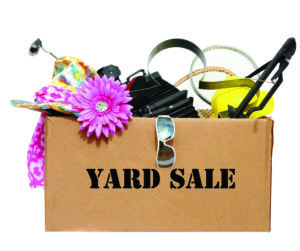 It’s shocking! How did I accumulate all this stuff? An embarrassment of riches may be a first-world problem — having too much of too many good things — but it is a reality for many of us, even those who don’t qualify as full-fledged hoarders. But even simple clutter has its own risks; for starters, the chronic and repeated stress caused by frantic and frustrated searching, and the risk of falling over precious possessions left in precarious places. In addition, clutter is distracting, saps time and energy, diminishes productivity and steals attention from more worthy endeavors. Overabundance can suck the pleasure right out of all this privilege.
It’s shocking! How did I accumulate all this stuff? An embarrassment of riches may be a first-world problem — having too much of too many good things — but it is a reality for many of us, even those who don’t qualify as full-fledged hoarders. But even simple clutter has its own risks; for starters, the chronic and repeated stress caused by frantic and frustrated searching, and the risk of falling over precious possessions left in precarious places. In addition, clutter is distracting, saps time and energy, diminishes productivity and steals attention from more worthy endeavors. Overabundance can suck the pleasure right out of all this privilege.
The reasons why we clutter are numerous, some rooted deep in the limbic system of the brain. What would happen if we ran out? And who hasn’t indulged in retail therapy to offset a bad day? It’s actually kind of patriotic to support our economy, right? Another good rationale is holding onto the past. Out of guilt or sentiment, you can collect trunks of useless gifts, for example. And if you don’t have a use for them, chances are very good that no one else will, either. But I think that if I dispose of something, I will need it, so there it sits, collecting dust and causing guilt.
Whatever the reason for our lifelong accumulation of treasures, sadly, the burden of clutter doesn’t even end when we die. If you have ever been left with a loved one’s home full of belonging, you may realize the impact that a cluttered home can have on others after we are gone. The process of disposing of an estate at an already stressful time can be costly and time-consuming.
 No, Ingrid, you can’t take it with you.
No, Ingrid, you can’t take it with you.
From the country that brought us an adult playground filled with budget-friendly, flat-packed DIY furniture comes a methodology that also exemplifies the sleek, stoic and sparse sensibilities of the Swedish lifestyle and hallmarks of Scandinavian minimalism.
Döstädning (pronounced duo-stad-ning), or Swedish death cleaning, is a decluttering and organization method stemming from the Swedish words “dö” (death) and “städning,” (cleaning). As the name denotes, death cleaning is designed to help its practitioners prepare for death. But it isn’t as morbid as it sounds. It is simply a way to make the downsizing process efficient and uplifting rather than overwhelming and depressing.
Döstädning is not about everyday dusting or mopping — it is about a permanent state of organization that makes your everyday life run more smoothly in the present, with an eye toward the future. The practical and pragmatic exercise involves getting rid of all the stuff you don’t need anymore so that no one else will be burdened with the task after you are gone. As it has often been described, it is meant to help you “clean your closet like there’s no tomorrow.”
And no, you don’t have to be Swedish to do it. The task of clearing out unnecessary belongings can be undertaken at any stage of life. But the goal is to do it well before others must do it for you… Unburdened by baggage (emotional and actual), you may find yourself less stressed and more focused once you’re living in a clean, organized space.
So let go of what doesn’t matter. Dig deeper into what is important. By “cleaning up your act,” you will be doing yourself a favor as well as those who will survive you. And getting rid of items can serve as a reminder that things don’t last forever, including us.
There have been many recent books written on the subject. Just search the internet for “Swedish death cleaning” and you will come upon many books that capture this bit of Scandinavian wisdom, encouraging readers to embrace minimalism, put things in order and possibly even broach sensitive conversations. Some of them have step-by-step instructions in addition to a description of the philosophy behind the methodology. If you want to get going immediately, here is a starter from “The Gentle Art of Swedish Death Cleaning.” and “Swedish Death Cleaning: A Beginner’s Guide (with Tips & Things to Know).”
Approach the project with this in mind: Which items will be of any value to others after you die?
STEP 1: Once you have evaluated your intent and mindset, begin the process. Reach out to friends and family and gently inform them of what you are doing, assuring them that you are simply decluttering your home. Explain the philosophy behind this method — that this cleaning strategy is ultimately about decreasing their stress. Discuss which belongings they would be interested in preserving. Affirm that your feelings will not be hurt if they do not want a particular item.
STEP 2: Deal with items with high sentimental value last as to avoid getting lost in reminiscence. Put these aside for later. Start with items that you cannot see — belongings stored in attics, closets and drawers that are generally of little sentimental value and easier to part with. Move on to bigger items, such as furniture, collectibles and books. Donate or sell everything that your friends and family members do not want.
 STEP 3: Next, organize your closets, clothes and shoes. Now is the time to get rid of all the things you have been holding on to “just in case.” The rule is, if you have not worn it within the last year, donate or sell it. Just like other possessions, if a certain clothing item has sentimental value to you, ask a loved one if it is something they would like to keep. If their answer is no, donate or sell it. Take comfort knowing that your favorite dress will “spark joy” for its new owner. Neatly organize your remaining clothes.
STEP 3: Next, organize your closets, clothes and shoes. Now is the time to get rid of all the things you have been holding on to “just in case.” The rule is, if you have not worn it within the last year, donate or sell it. Just like other possessions, if a certain clothing item has sentimental value to you, ask a loved one if it is something they would like to keep. If their answer is no, donate or sell it. Take comfort knowing that your favorite dress will “spark joy” for its new owner. Neatly organize your remaining clothes.
STEP 4: Lastly, sort through sentimental items — photographs, heirlooms and letters. Again, discuss with loved ones which items they would like to keep; create a box for the rest. This box will contain those belongings that are special to you but insignificant to others. Leave instructions stating what should be done with the box — even if that means throwing it away.
Remember, if any of the items you are keeping have significant value, leave instructions for whoever will clear out your home. Remember, Swedish death cleaning is meant to be an invaluable gift that you can give your loved ones that simplifies their lives, as well as yours.



Leave a Reply